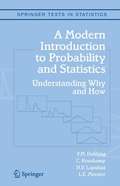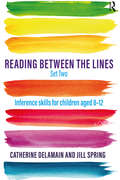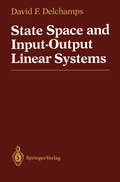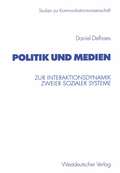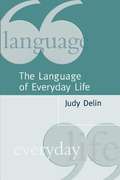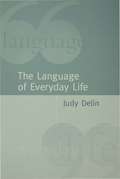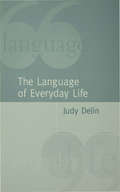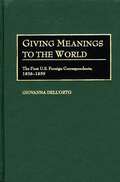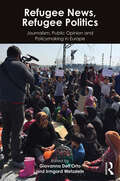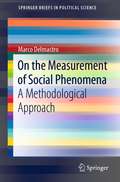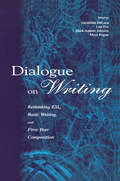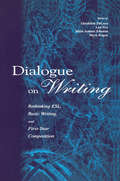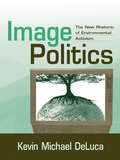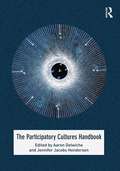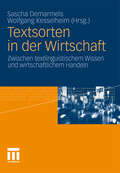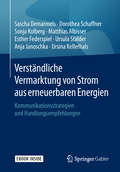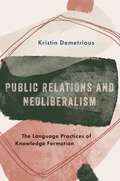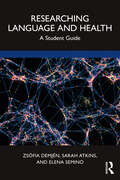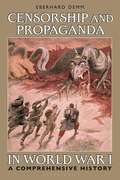- Table View
- List View
A Modern Introduction to Probability and Statistics: Understanding Why and How (PDF)
by F. M. Dekking C. Kraaikamp H. P. Lopuhaa L. E. MeesterProbability and Statistics are studied by most science students, usually as a second- or third-year course. Many current texts in the area are just cookbooks and, as a result, students do not know why they perform the methods they are taught, or why the methods work. The strength of this book is that it readdresses these shortcomings; by using examples, often from real-life and using real data, the authors can show how the fundamentals of probabilistic and statistical theories arise intuitively. It provides a tried and tested, self-contained course, that can also be used for self-study. A Modern Introduction to Probability and Statistics has numerous quick exercises to give direct feedback to the students. In addition the book contains over 350 exercises, half of which have answers, of which half have full solutions. A website at www.springeronline.com/1-85233-896-2 gives access to the data files used in the text, and, for instructors, the remaining solutions. The only pre-requisite for the book is a first course in calculus; the text covers standard statistics and probability material, and develops beyond traditional parametric models to the Poisson process, and on to useful modern methods such as the bootstrap. This will be a key text for undergraduates in Computer Science, Physics, Mathematics, Chemistry, Biology and Business Studies who are studying a mathematical statistics course, and also for more intensive engineering statistics courses for undergraduates in all engineering subjects.
Reading Between the Lines Set Two: Inference skills for children aged 8 – 12
by Catherine Delamain Jill SpringReading Between the Lines Set Two is a sequel to the popular Reading Between the Lines. It is a resource book for teachers, teaching assistants, SENCOs and Speech and Language Therapists who need to support the development of inference skills in children aged 8–12. These unique guides offer accessible and easy-to-use material specifically targeted to improve inference, which is a crucial element in understanding spoken and written language. The book provides 370 engaging texts themed around different areas such as place and occupation, and includes short stories about everyday events, magic and adventure. Each short text is accompanied by guiding questions and is carefully graded to allow students to gradually progress from more simple texts with highlighted clues onto more challenging scenarios which will require higher level inferencing skills. Containing handy photocopiable material, this guide can be used with whole classes, small groups or individual children. It will be particularly valuable to professionals working with children who have Autism Spectrum Disorders or Speech, Language and Communication Needs, who need particular support with inference as they develop their broader social communication skills.
Reading Between the Lines Set Two: Inference skills for children aged 8 – 12
by Catherine Delamain Jill SpringReading Between the Lines Set Two is a sequel to the popular Reading Between the Lines. It is a resource book for teachers, teaching assistants, SENCOs and Speech and Language Therapists who need to support the development of inference skills in children aged 8–12. These unique guides offer accessible and easy-to-use material specifically targeted to improve inference, which is a crucial element in understanding spoken and written language. The book provides 370 engaging texts themed around different areas such as place and occupation, and includes short stories about everyday events, magic and adventure. Each short text is accompanied by guiding questions and is carefully graded to allow students to gradually progress from more simple texts with highlighted clues onto more challenging scenarios which will require higher level inferencing skills. Containing handy photocopiable material, this guide can be used with whole classes, small groups or individual children. It will be particularly valuable to professionals working with children who have Autism Spectrum Disorders or Speech, Language and Communication Needs, who need particular support with inference as they develop their broader social communication skills.
State Space and Input-Output Linear Systems
by David F. DelchampsIt is difficult for me to forget the mild sense of betrayal I felt some ten years ago when I discovered, with considerable dismay, that my two favorite books on linear system theory - Desoer's Notes for a Second Course on Linear Systems and Brockett's Finite Dimensional Linear Systems - were both out of print. Since that time, of course, linear system theory has undergone a transformation of the sort which always attends the maturation of a theory whose range of applicability is expanding in a fashion governed by technological developments and by the rate at which such advances become a part of engineering practice. The growth of the field has inspired the publication of some excellent books; the encyclopedic treatises by Kailath and Chen, in particular, come immediately to mind. Nonetheless, I was inspired to write this book primarily by my practical needs as a teacher and researcher in the field. For the past five years, I have taught a one semester first year gradu ate level linear system theory course in the School of Electrical Engineering at Cornell. The members of the class have always come from a variety of departments and backgrounds, and con sequently have entered the class with levels of preparation ranging from first year calculus and a taste of transform theory on the one extreme to senior level real analysis and abstract algebra on the other.
Politik und Medien: Zur Interaktionsdynamik zweier sozialer Systeme (Studien zur Kommunikationswissenschaft)
by Daniel DelhaesDas Buch untersucht das Verhältnis von Politik und Medien in der modernen Kommunikationsgesellschaft. Anhand öffentlich kontrovers diskutierter Themen unter der ersten rot-grünen Bundesregierung wird gezeigt, dass Medien einer eigenen Systemlogik folgen und sich nicht von Politik steuern lassen.
The Language Of Everyday Life: an Introduction (PDF)
by Judy DelinThis is a tour de force. It combines luminous discussion of the core conceptual issues of cultural studies, with a hard-headed, practical sense of how research in the field gets done. The result is a seriously smart, comprehensive survey of the whole terrain of cultural studies itself.
The Language of Everyday Life: An Introduction (PDF)
by Judy DelinThis is a lively, practical guide that provides a fascinating linguistic description of six familiar text and discourse types, showing how language works in everyday life to perform its particular purpose. Through original examples, students are introduced to a wide-ranging repertoire of analytical concepts and techniques, described in basic, clear terms, and drawn from a broad range of areas of linguistics and language study. The aim of the book is to enable students to discover for themselves what is interesting about different language situations, and to begin to interrogate the relationship between language, society, and ideology. The Language of Everyday Life includes: topics for discussion; exercises, and; further readings; extensive glossary of technical terms; a practical guide to project work.
The Language of Everyday Life: An Introduction
by Judy DelinThis is a lively, practical guide that provides a fascinating linguistic description of six familiar text and discourse types, showing how language works in everyday life to perform its particular purpose. Through original examples, students are introduced to a wide-ranging repertoire of analytical concepts and techniques, described in basic, clear terms, and drawn from a broad range of areas of linguistics and language study. The aim of the book is to enable students to discover for themselves what is interesting about different language situations, and to begin to interrogate the relationship between language, society, and ideology. The Language of Everyday Life includes: topics for discussion; exercises, and; further readings; extensive glossary of technical terms; a practical guide to project work.
Giving Meanings to the World: The First U.S. Foreign Correspondents, 1838-1859 (Contributions to the Study of Mass Media and Communications)
by Giovanna Dell'OrtoHow did the first United States foreign correspondents help shape an American common sense about the rest of the world? This new study is the first to address this key question, examining the images of foreign countries that emerge from the first formally organized American foreign correspondence. Its focus is on the discourses of the world constructed in mid-19th-century correspondence, which provided American newspaper readers with their first cohesive view of the world outside its borders. By emphasizing the emergence of foreign correspondence across its first two decades (1838-1859), and by comparing it to images in editorial and congressional debates of the time, Giovanna Dell'Orto's analysis addresses the pivotal question of what meanings were ascribed to foreign cultures during this key time.Giving Meanings to the World also establishes for the first time in scholarly literature the early history of the content of foreign news and editorials in American newspapers while also exploring alternative constructions of foreign cultures in the correspondence for an African-American newspaper and by women writers. Unique in both subject matter and approach, this work gathers together and puts into perspective an array of information and discussion about how America viewed other nations in the early days of foreign correspondence.
Refugee News, Refugee Politics: Journalism, Public Opinion and Policymaking in Europe
by Giovanna Dell’Orto Irmgard WetzsteinThe unprecedented arrival of more than a million refugees, asylum seekers, and migrants – plus the political, public, and policy reactions to it – is redefining Europe. The repercussions will last for generations on such central issues as security, national identity, human rights, and the very structure of liberal democracies. What is the role of the news media in telling the story of the 2010s refugee crisis at a time of deepening crisis for journalism, as “fake news” ran rampant amid an increasingly distrustful public? This volume offers students, scholars, and the general reader original research and candid frontline insights to understand the intersecting influences of journalistic practices, news discourses, public opinion, and policymaking on one of the most polarizing issues of our time. Focusing on current events in Greece, Austria, and Germany – critical entry and destination countries – it introduces a groundbreaking dialogue between elite national and international media, academic institutions, and civil society organizations, revealing the complex impacts of the news media on the thorny sociopolitical dilemmas raised by the integration of hundreds of thousands of asylum seekers in EU countries.
On the Measurement of Social Phenomena: A Methodological Approach (SpringerBriefs in Political Science)
by Marco DelmastroThis book explores the analysis of social phenomena, using a multidisciplinary approach while addressing statistical, economic, sociological, as well as psychological issues.The author presents a detailed account of the procedures and techniques used to gather, process, and analyze data. Topics covered include, but are not limited to survey data, content analysis data, data visualization, as well as data about crimes.The book addresses this methodological framework that drives applied social sciences in an applicative and simple way, by analyzing key social phenomena such as the threats to journalism, the so-called chilling effect, and the market for news. Finally, the author examines the data and measures of the recent COVID-19 pandemic.This book is a must-read for everybody interested in a better understanding of the methodological analysis of social phenomena, social and political methodology, and applied science in general.
Dialogue on Writing: Rethinking Esl, Basic Writing, and First-year Composition
by Geraldine DeLuca Len Fox Mark-Ameen Johnson Myra KogenDesigned for courses on theories and methods of teaching college writing, this text is distinguished by its emphasis on giving teachers a foundation of knowledge for teaching writing to a diverse student body. As such, it is equally relevant for teacher training in basic writing, ESL, and first year composition, the premise being that in most colleges and universities today teachers of each of these types of courses encounter similar student populations and teaching challenges. Many instructors compile packets of articles for this course because they cannot find an appropriate collection in one volume. This text fills that gap. It includes in one volume: *the latest thinking about teaching and tutoring basic writing, ESL, and first year composition students; *seminal articles, carefully selected to be accessible to those new to the field, by classic authors in the field of composition and ESL, as well as a number of new voices; *attention to both theory and practice, but with an emphasis on practice; and *articles about non-traditional students, multiculturalism, and writing across the disciplines. The text includes suggestions for pedagogy and invitations for exploration to engage readers in reflection and in applications to their own teaching practice.
Dialogue on Writing: Rethinking Esl, Basic Writing, and First-year Composition
by Geraldine DeLuca Mark-Ameen Johnson Len Fox Myra Kogen Geri DeLucaDesigned for courses on theories and methods of teaching college writing, this text is distinguished by its emphasis on giving teachers a foundation of knowledge for teaching writing to a diverse student body. As such, it is equally relevant for teacher training in basic writing, ESL, and first year composition, the premise being that in most colleges and universities today teachers of each of these types of courses encounter similar student populations and teaching challenges. Many instructors compile packets of articles for this course because they cannot find an appropriate collection in one volume. This text fills that gap. It includes in one volume: *the latest thinking about teaching and tutoring basic writing, ESL, and first year composition students; *seminal articles, carefully selected to be accessible to those new to the field, by classic authors in the field of composition and ESL, as well as a number of new voices; *attention to both theory and practice, but with an emphasis on practice; and *articles about non-traditional students, multiculturalism, and writing across the disciplines. The text includes suggestions for pedagogy and invitations for exploration to engage readers in reflection and in applications to their own teaching practice.
Image Politics: The New Rhetoric of Environmental Activism (Revisioning Rhetoric Ser.)
by Kevin Michael DeLucaThis exceptional volume examines “image events” as a rhetorical tactic utilized by environmental activists. Author Kevin Michael DeLuca analyzes widely televised environmentalist actions in depth to illustrate how the image event fulfills fundamental rhetorical functions in constructing and transforming identities, discourses, communities, cultures, and world views. Image Politics also exhibits how such events create opportunities for a politics that does not rely on centralized leadership or universal metanarratives. The book presents a rhetoric of the visual for our mediated age as it illuminates new political possibilities currently enacted by radical environmental groups. Chapters in the volume cover key areas of environmental activism such as:*The rhetoric of social movements;*Imaging social movements;*Environmental justice groups; and*Participatory democracy. This book is of interest to scholars and students of rhetorical theory, media and communication theory, visual theory, environmental studies, social change movements, and political theory. It will also appeal to others interested in ecology, radical environmental politics, and activism, and is an excellent supplemental text in advanced undergraduate and graduate level courses in these areas.
Image Politics: The New Rhetoric of Environmental Activism
by Kevin Michael DeLucaThis exceptional volume examines “image events” as a rhetorical tactic utilized by environmental activists. Author Kevin Michael DeLuca analyzes widely televised environmentalist actions in depth to illustrate how the image event fulfills fundamental rhetorical functions in constructing and transforming identities, discourses, communities, cultures, and world views. Image Politics also exhibits how such events create opportunities for a politics that does not rely on centralized leadership or universal metanarratives. The book presents a rhetoric of the visual for our mediated age as it illuminates new political possibilities currently enacted by radical environmental groups. Chapters in the volume cover key areas of environmental activism such as:*The rhetoric of social movements;*Imaging social movements;*Environmental justice groups; and*Participatory democracy. This book is of interest to scholars and students of rhetorical theory, media and communication theory, visual theory, environmental studies, social change movements, and political theory. It will also appeal to others interested in ecology, radical environmental politics, and activism, and is an excellent supplemental text in advanced undergraduate and graduate level courses in these areas.
The Participatory Cultures Handbook
by Aaron Delwiche Jennifer Jacobs HendersonHow did we get from Hollywood to YouTube? What makes Wikipedia so different from a traditional encyclopedia? Has blogging dismantled journalism as we know it? Our media landscape has undergone a seismic shift as digital technology has fostered the rise of "participatory culture," in which knowledge is originated, created, distributed, and evaluated in radically new ways. The Participatory Cultures Handbook is an indispensable, interdisciplinary guide to this rapidly changing terrain. With short, accessible essays from leading geographers, political scientists, communication theorists, game designers, activists, policy makers, physicists, and poets, this volume will introduce students to the concept of participatory culture, explain how researchers approach participatory culture studies, and provide original examples of participatory culture in action. Topics include crowdsourcing, crisis mapping, grid computing, digital activism in authoritarian countries, collaborative poetry, collective intelligence, participatory budgeting, and the relationship between video games and civic engagement. Contributors include: Daren Brabham, Helen Burgess, Clay Calvert, Mia Consalvo, Kelly Czarnecki, David M. Faris, Dieter Fuchs, Owen Gallagher, Clive Goodinson, Alexander Halvais, Cynthia Hawkins, John Heaven, The Jannissary Collective, Henry Jenkins, Barry Joseph, Christopher Kelty, Pierre Lévy, Sophia B. Liu, Rolf Luehrs, Patrick Meier, Jason Mittell, Sarah Pearce, W. James Potter, Howard Rheingold, Suzanne Scott, Benjamin Stokes, Thomas Swiss, Paul Taylor, Will Venters, Jen Ziemke
The Participatory Cultures Handbook
by Aaron Delwiche Jennifer Jacobs HendersonHow did we get from Hollywood to YouTube? What makes Wikipedia so different from a traditional encyclopedia? Has blogging dismantled journalism as we know it? Our media landscape has undergone a seismic shift as digital technology has fostered the rise of "participatory culture," in which knowledge is originated, created, distributed, and evaluated in radically new ways. The Participatory Cultures Handbook is an indispensable, interdisciplinary guide to this rapidly changing terrain. With short, accessible essays from leading geographers, political scientists, communication theorists, game designers, activists, policy makers, physicists, and poets, this volume will introduce students to the concept of participatory culture, explain how researchers approach participatory culture studies, and provide original examples of participatory culture in action. Topics include crowdsourcing, crisis mapping, grid computing, digital activism in authoritarian countries, collaborative poetry, collective intelligence, participatory budgeting, and the relationship between video games and civic engagement. Contributors include: Daren Brabham, Helen Burgess, Clay Calvert, Mia Consalvo, Kelly Czarnecki, David M. Faris, Dieter Fuchs, Owen Gallagher, Clive Goodinson, Alexander Halvais, Cynthia Hawkins, John Heaven, The Jannissary Collective, Henry Jenkins, Barry Joseph, Christopher Kelty, Pierre Lévy, Sophia B. Liu, Rolf Luehrs, Patrick Meier, Jason Mittell, Sarah Pearce, W. James Potter, Howard Rheingold, Suzanne Scott, Benjamin Stokes, Thomas Swiss, Paul Taylor, Will Venters, Jen Ziemke
Textsorten in der Wirtschaft: Zwischen textlinguistischem Wissen und wirtschaftlichem Handeln
by Sascha Demarmels Wolfgang KesselheimDie Erforschung von Wirtschaftstextsorten ist in besonderem Maße auf eine enge Verzahnung von wirtschaftlicher Praxis und linguistischer Wissenschaft angewiesen. Das gilt gerade auch dann, wenn es darum geht, Studierende in die erfolgreiche Produktion von Wirtschaftstexten einzuführen. Wie aber ist das Verhältnis zwischen Sprachwissenschaft, wirtschaftlicher Praxis und Lehre im Umgang mit Wirtschaftstextsorten zu bestimmen? Im vorliegenden Sammelband werden unterschiedliche Zugänge zum Gegenstand Wirtschaftstextsorten dargestellt, Spannungsfelder ausgeleuchtet und Übergänge zwischen den einzelnen Bereichen aufgezeigt.
Verständliche Vermarktung von Strom aus erneuerbaren Energien: Kommunikationsstrategien und Handlungsempfehlungen
by Sascha Demarmels Dorothea Schaffner Sonja Kolberg Matthias Albisser Esther Federspiel Ursula Stalder Anja Janoschka Ursina KellerhalsDieses Buch untersucht, wie sich Stromprodukte aus erneuerbaren Energien verständlich vermarkten lassen, sodass die Konsumentinnen und Konsumenten den Mehrwert dieser Produkte verstehen und eine informierte Kaufentscheidung treffen. Eine Toolbox liefert Handlungsempfehlungen und erläutert Kommunikationsstrategien wie Gamification, Storytelling, Vereinfachung und Visualisierung. Basis der Handlungsempfehlungen sind Experteninterviews, in Experimenten getestete Pilotbeispiele sowie von Partnerunternehmen entwickelte Kommunikationsbeispiele, die in der Praxis umgesetzt und als Feldexperiment geprüft wurden.Der InhaltStrommarkt und -marketing in den DACH LändernForschungsstand "Angewandte Verständlichkeit"Kommunikationsstrategien zur Steigerung der Verarbeitungsmotivation und deren ValidierungBest-Practice-Beispiele aus verschiedenen Ländern Toolbox.
Public Relations and Neoliberalism: The Language Practices of Knowledge Formation
by Kristin DemetriousFocusing on two of the most fraught and intractable public debates of the present time: human-induced climate change and the human rights of refugees, asylum seekers, immigrants and the stateless, this book raises critical questions about the role and relationship of public relations in weakening democratic political systems. It shows a clear, but often indirect, link between PR and a neoliberal agenda that has been vastly underestimated and oversimplified as "spin." This comes at a great cost for society. Public Relations and Neoliberalism provides a panoramic view of public relations from the post-war period, when a powerful communication template propelled by the PR industry served the neoliberal agenda to create political diversion, division, and hegemony at the same time. But today, public relations is not just a tool of industry or government. Rather, it has become the default mode and style of being and relating in the world, that seeps into and affects all areas of life: professional, corporate, domestic, political, activist, and technological. And the metastasis of neoliberal meaning into so many realms has important ramifications for society and individuals. Looking at the confluences and contradictions within the logic of public relations both as a practice and in terms of how it has been theorized and understood, this book provides an important contribution to critical work in the communicative field.
Public Relations and Neoliberalism: The Language Practices of Knowledge Formation
by Kristin DemetriousFocusing on two of the most fraught and intractable public debates of the present time: human-induced climate change and the human rights of refugees, asylum seekers, immigrants and the stateless, this book raises critical questions about the role and relationship of public relations in weakening democratic political systems. It shows a clear, but often indirect, link between PR and a neoliberal agenda that has been vastly underestimated and oversimplified as "spin." This comes at a great cost for society. Public Relations and Neoliberalism provides a panoramic view of public relations from the post-war period, when a powerful communication template propelled by the PR industry served the neoliberal agenda to create political diversion, division, and hegemony at the same time. But today, public relations is not just a tool of industry or government. Rather, it has become the default mode and style of being and relating in the world, that seeps into and affects all areas of life: professional, corporate, domestic, political, activist, and technological. And the metastasis of neoliberal meaning into so many realms has important ramifications for society and individuals. Looking at the confluences and contradictions within the logic of public relations both as a practice and in terms of how it has been theorized and understood, this book provides an important contribution to critical work in the communicative field.
Researching Language and Health: A Student Guide
by Zsófia Demjén Sarah Atkins Elena SeminoResearching Language and Health explores key topics in illness and healthcare contexts through multiple linguistic lenses. This book highlights key themes, guides readers through the design stages of research and the ethical considerations specific to linguistic health research, and brings methods and methodologies to life by demonstrating how these can be applied to specific issues in context. Covering a wide range of health conditions, healthcare contexts, and data types, with an emphasis on those most accessible to students and new researchers, the authors foreground the ‘so what?’ of research and the impact that linguistic studies can have. Both a guide to key elements of the research process and a holistic view of research projects that have been successful, insightful, and impactful in different contexts, this is an essential text for advanced students and researchers in healthcare communication and applied linguistics.
Researching Language and Health: A Student Guide
by Zsófia Demjén Sarah Atkins Elena SeminoResearching Language and Health explores key topics in illness and healthcare contexts through multiple linguistic lenses. This book highlights key themes, guides readers through the design stages of research and the ethical considerations specific to linguistic health research, and brings methods and methodologies to life by demonstrating how these can be applied to specific issues in context. Covering a wide range of health conditions, healthcare contexts, and data types, with an emphasis on those most accessible to students and new researchers, the authors foreground the ‘so what?’ of research and the impact that linguistic studies can have. Both a guide to key elements of the research process and a holistic view of research projects that have been successful, insightful, and impactful in different contexts, this is an essential text for advanced students and researchers in healthcare communication and applied linguistics.
Censorship and Propaganda in World War I: A Comprehensive History (International Library of Twentieth Century History)
by Eberhard DemmThis book demonstrates how people were kept ignorant by censorship and indoctrinated by propaganda. Censorship suppressed all information that criticized the army and government, that might trouble the population or weaken its morale. Propaganda at home emphasized the superiority of the fatherland, explained setbacks by blaming scapegoats, vilified and ridiculed the enemy, warned of the disastrous consequences of defeat and extolled duty and sacrifice. The propaganda message also infiltrated entertainment and the visual arts. Abroad it aimed to demoralize enemy troops and stir up unrest among national minorities and other marginalized groups. The many illustrations and organograms provide a clear visual demonstration of Demm's argument.
Censorship and Propaganda in World War I: A Comprehensive History (International Library of Twentieth Century History)
by Eberhard DemmThis book demonstrates how people were kept ignorant by censorship and indoctrinated by propaganda. Censorship suppressed all information that criticized the army and government, that might trouble the population or weaken its morale. Propaganda at home emphasized the superiority of the fatherland, explained setbacks by blaming scapegoats, vilified and ridiculed the enemy, warned of the disastrous consequences of defeat and extolled duty and sacrifice. The propaganda message also infiltrated entertainment and the visual arts. Abroad it aimed to demoralize enemy troops and stir up unrest among national minorities and other marginalized groups. The many illustrations and organograms provide a clear visual demonstration of Demm's argument.
